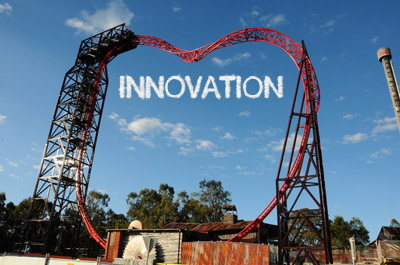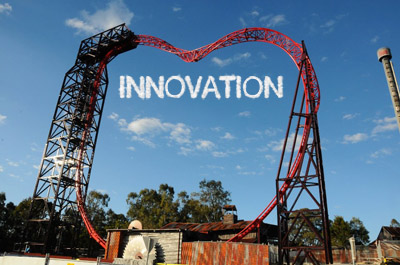Inspiration from Dreamworld’s BuzzSaw: Riding innovation with integration and action
I attended an evening launch of Dreamworld’s new BuzzSaw ride last week. Spinning around at 105 kmh, I calmly considered the innovation necessary to get me in the seat. As I stumbled away on shaking legs, I asked the question: “Is innovation all about big exciting rides, or is there more?” The look on my face during the event also reminds me that innovation is not for the faint of heart.

An evening buzzing with fear and fun
Dreamworld held the partner event to showcase their new Buzz Saw ride, the tallest inversion in the Southern Hemisphere and the second highest inversion worldwide.
The event started with choreographed ghosts telling the story of Jack Darke who died in the saw mill in 1887.

As the ghosts told their tale, zombies wandered amongst the living. A few were kind enough to stop for pictures.



After putting it off as long as we could, we entered the queue, walking past relics of days past before coming to the sign no one obeyed.


The ghosts, zombies, and effects of the event, the engineering effort to design the ride, and the management required to get the ride in place all spoke to a holistic approach towards innovation. As the smoke lifted to reveal the actors behind the scene, our conversations turned to what is necessary for such innovation to occur.
Innovation research: Revealing a need for integration and action
What predicts innovation?
Innovation does not just happen. A study reviewed 28 years of innovation research to ask the question “What predicts innovation?”
Four hundred research projects confirmed that innovation is more likely if you have:
- Individual personality traits of openness and creativity.
- People with higher education levels and longer tenure.
- People who are motivated by the task itself as well as motivated by things outside the task such as rewards.
- People who believe they can do the job (job self-efficacy) and believe in their ability to be creative in general (creative self-efficacy).
- An organisational culture of innovation and creativity.
- A positive work climate.
- Sufficient financial, training, and technical supporting resources.
- Appropriate leadership, transformational leadership specifically.
- Sufficient complexity of the job, role and/or project, as complex jobs are less routine, more challenging and promote idea generation.
- Appropriate levels of autonomy.
- An expectation of the person to be innovative, based on the self-fulfilling prophesy factor of the “Pygmalion Effect”.
Apply all these in more than one area…
Not only do you need to consider these factors, but you should apply these over a range of areas. Another research project analysed data from 16,383 British companies. They outlined seven innovation areas:
- Product innovation
- Process innovation
- Technology innovation
- Strategy innovation
- Management innovation
- Organisation structure innovation
- Marketing innovation
The study found that the more a company invested in one innovation area (for example, a big investment in product innovation), the more likely they were to be active in multiple areas.
This outcome is supported by another research project that found marketing managers who focused on product innovation were also involved in other innovation areas and depended on knowledge outside of the traditional scope of marketing’s periphery.
And make sure your ideas are supported by action
Innovation is not just ideas, it is also action. Research into person-innovation fit shows that alignment of innovation values between staff and their organisation is critical. Studies confirm commitment must be supported with individuals who have the appropriate abilities. Organisations must have vision and commitment for innovation as well as the means to carry it out.
Innovation: “It’s a ripper of a ride”

The sign stating “Don’t go in here” and the faces of those on the ride act as appropriate metaphors for those looking to inject innovation into their businesses. I have blurred out others in the picture, as some may not appreciate having the world see our carefully controlled social masks discarded at an acceleration of +5G. My own visage was not dissimilar to others, a mixture of fear and excitement through an expression that could be either joy or pain.
Such is the way with the risks and rewards of innovation. The previously mentioned study of British companies noted that only 19 percent of the 16,383 companies were heavy adopters of innovation. If innovation was easy, it would not be defined as new.
I can confirm the three main areas of research findings against my own clients who engage in digital services:
- Innovation predictors
I have seen digital solutions fail without the right mix of innovation predictors. You need innovation predictors to ensure innovative activities maintain momentum and can continue beyond individual personalities. - Innovation areas
Digital solutions are rarely the only innovative investment. What we provide is frequently part of a holistic strategy involving parallel projects in other areas such as management, product, and strategy. - Action
Digital solutions are expressions of really good ideas. Similar to constructing a theme park ride, you need those with the appropriate experience to move beyond ideas and into implementation.
Innovation is not easy. It requires many factors and synergy between many areas. Once all the pieces are in place, however, it’s a thrilling experience worth the price of admission.

